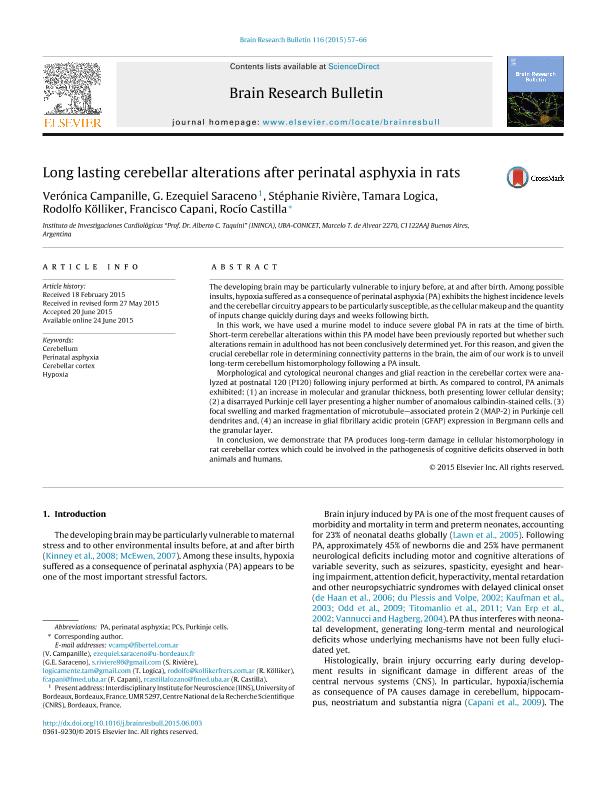Artículo
Long lasting cerebellar alterations after perinatal asphyxia in rats
Campanille, Veronica; Saraceno, Gustavo Ezequiel ; Riviere, Stephanie
; Riviere, Stephanie ; Logica Tornatore, Tamara Maite Ayelén
; Logica Tornatore, Tamara Maite Ayelén ; Kolliker Frers, Rodolfo Alberto
; Kolliker Frers, Rodolfo Alberto ; Capani, Francisco
; Capani, Francisco ; Castilla Lozano, Maria del Rocio
; Castilla Lozano, Maria del Rocio
 ; Riviere, Stephanie
; Riviere, Stephanie ; Logica Tornatore, Tamara Maite Ayelén
; Logica Tornatore, Tamara Maite Ayelén ; Kolliker Frers, Rodolfo Alberto
; Kolliker Frers, Rodolfo Alberto ; Capani, Francisco
; Capani, Francisco ; Castilla Lozano, Maria del Rocio
; Castilla Lozano, Maria del Rocio
Fecha de publicación:
07/2015
Editorial:
Elsevier
Revista:
Brain Research Bulletin
ISSN:
0361-9230
Idioma:
Inglés
Tipo de recurso:
Artículo publicado
Clasificación temática:
Resumen
The developing brain may be particularly vulnerable to injury before, at and after birth. Among possible insults, hypoxia suffered as a consequence of perinatal asphyxia (PA) exhibits the highest incidence levels and the cerebellar circuitry appears to be particularly susceptible, as the cellular makeup and the quantity of inputs change quickly during days and weeks following birth. In this work, we have used a murine model to induce severe global PA in rats at the time of birth. Short-term cerebellar alterations within this PA model have been previously reported but whether such alterations remain in adulthood has not been conclusively determined yet. For this reason, and given the crucial cerebellar role in determining connectivity patterns in the brain, the aim of our work is to unveil long-term cerebellum histomorphology following a PA insult. Morphological and cytological neuronal changes and glial reaction in the cerebellar cortex were analyzed at postnatal 120 (P120) following injury performed at birth. As compared to control, PA animals exhibited: (1) an increase in molecular and granular thickness, both presenting lower cellular density; (2) a disarrayed Purkinje cell layer presenting a higher number of anomalous calbindin-stained cells. (3) focal swelling and marked fragmentation of microtubule-associated protein 2 (MAP-2) in Purkinje cell dendrites and, (4) an increase in glial fibrillary acidic protein (GFAP) expression in Bergmann cells and the granular layer. In conclusion, we demonstrate that PA produces long-term damage in cellular histomorphology in rat cerebellar cortex which could be involved in the pathogenesis of cognitive deficits observed in both animals and humans.
Palabras clave:
Cerebellum
,
Perinatal Asphyxia
,
Cerebellar Cortex
,
Hypoxia
Archivos asociados
Licencia
Identificadores
Colecciones
Articulos(ININCA)
Articulos de INST.DE INVEST.CARDIOLOGICAS (I)
Articulos de INST.DE INVEST.CARDIOLOGICAS (I)
Citación
Campanille, Veronica; Saraceno, Gustavo Ezequiel; Riviere, Stephanie; Logica Tornatore, Tamara Maite Ayelén; Kolliker Frers, Rodolfo Alberto; et al.; Long lasting cerebellar alterations after perinatal asphyxia in rats; Elsevier; Brain Research Bulletin; 116; 7-2015; 57-66
Compartir
Altmétricas



